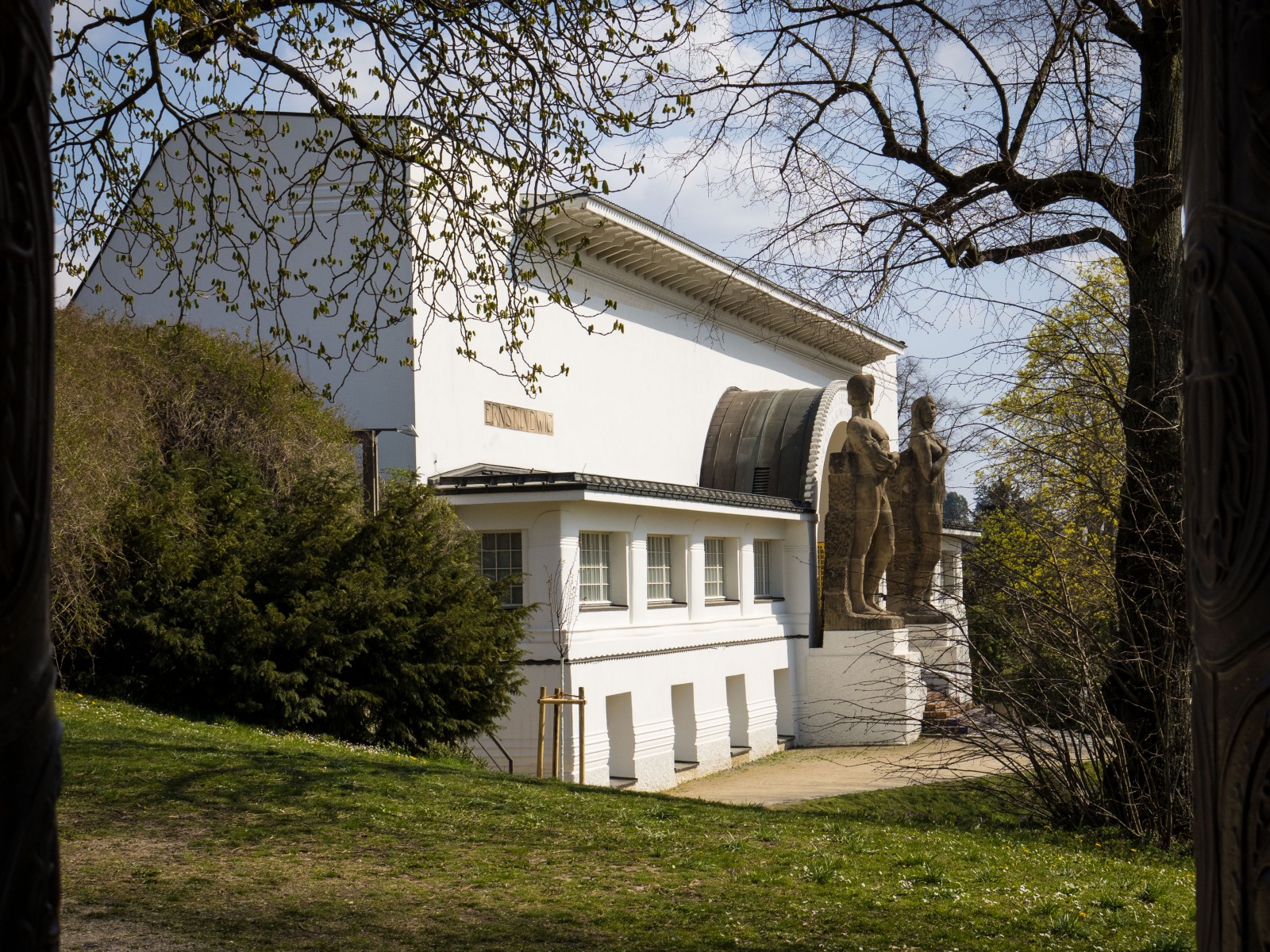These photos were taken in Mathildenhöhe from January to March 2021.

Congratulations to the city of Darmstadt for finally achieving the UNESCO World Heritage status for the Artist Colony (Künstlerkolonie) of Mathildenhöhe. The site consists of the ensemble of buildings, gardens,sculptures and artefacts that form the core of the Jugendstil art movement, the German version of Art Nouveau. Darmstadts’ UNESCO application, merits the UNESCO World Heritage status, due to the significant influence of the colony’s activities on subsequent art movements such as Bauhaus and contemporary modern life.


Ernst Ludwig Haus (1901)
The celebrated Jugendstil artistic movement of Mathildenhöhe began in 1899 when the art loving Grand Duke Ernst Ludwig of Hesse created the artist colony, by appointing the first seven celebrated artists, under the leadership of Joseph Maria Olbrich.
The artists were invited by the Duke because of their recognised talent.
The buildings, gardens and works of the colony, form a unique ‘Total Work of Art’ (Gesamtkunst-work), the concept that incorporates art into daily life.
The Ernst Ludwig Haus (image to the left and below) is a building complex containing the artists ateliers and an exhibition space. The name of the Duke is prominent on the facade. The main entrance (below) can be interpreted as entering an ideal world of art. It is the centre of the artist colony.

The Colony’s Exhibitions:
- In 1901 the first exhibition took place entitled “Ein Dokument deutscher Kunst”- ‘ A Document of German Art’- inaugurated the colony.
- Three more exhibitions took place in the colony:
- 1904- “Dreihäusergruppe”— ‘group of three houses’. Demonstrate bourgeois living.
- 1908- ‘Hessische Landesausstellung für Freie und Angewandte Kunst’- Hessian State Exhibition for Free and Applied Arts. Handicrafts from the whole state.
- 1914- Platanenhain- Plane Tree Grove. The theme of the fourth and final exhibition was Plane Tree Grove and the artistic decoration of the Lilien-becken- basin of lilies- built to integrate the Russian Chapel.
Activity was halted in the thriving colony because of the World War in 1914.

For the colony’s fourth and final exhibition in 1914, the sculptor and architect Bernhard Hoetger (1874-1949) was commissioned to provide the grove with his own sculptures. Hoetger joined the colony in 1911 to design the grove artistically. He developed a total work of art with sculptures, relief walls and inscriptions, adopting the theme of the cycle of all life – using water as a symbol.
The Hochzeitsturm (1908)


The Hochzeitsturm and the Grand Exhibition Hall, were inaugurated in the colony’s third exhibition. The tower can be seen from the city centre, with its protruding five fingers. It is the landmark of the colony and also of Darmstadt. It was designed by Olbrich for the occasion of the Grand Duke’s second marriage to Eleonore of Solms-Hohensolms-Lich. The tower is a wedding memorial, a gift from the city to honour the couple. It is still used today for the city’s state marriages. The tower was completed in 1908 and is 48 meters high, with a combination of abstract forms. The Wedding Tower has been completely preserved in its original state. During the bombing in 1944, only the roof of the five pinnacles was destroyed and later renewed. The relief is by sculptor Heinrich Jobst (1874- 1943) and the sun dial is designed by artist Friedrich Wilhelm Kleukens (1878-1956). The Poem below the sundail is by Rudolf Binding (1867–1938).

The total work of art, artefacts created by Joseph Maria Olbrich (1867-1908) and Peter Behrens (1868-1940) garnered international acclaims and awards. Their individual successes as well as that of the 1901 Darmstadt exhibition, led to the exemplary status of the Mathildenhöhe as model for later major architecture exhibitions.



Jewellery by Joseph Maria Olbrich. Table Clock by Olbrich, 1902
“Total Works of Art” (Gesamtkunstwerk), transcends architecture by incorporating art in daily life via interior design, furniture and household items such as clocks, crockery and jewellery.
Joseph Maria Olbrich Haus (1901)


Olbrich’s own house was built in 1901 in time for the first exhibition. The facade tiles are significant for their chessboard patterns and strong contrast for graphic effects. Olbrich’s signature style of white and blue can also be seen on the lamps. The white & blue signature style was inspired by a study trip to North Africa. Olbrich was the main artist of the colony, until his death in 1907. Olbrich was summoned by the Duke to Darmstadt in 1899, after being a founding member of the Vienna Secession movement; He was instrumental in the foundation of the artist colony. The colony’s first exhibition in 1901 bought him his own house and numerous international commissions. He died in 1908 from leukaemia. The Olbrich house is next door to Hans Christensen’s house, which was destroyed in the war. The wall fountain is designed by Ludwig Habich (1872-1949).
The Colony’s Houses

The artists houses were open to the public at the time the colony was active from 1901 to 1914 to demonstrate ‘Total Works of Art’.
Private Houses of the colony’s artists were part of the exhibitions with which the Mathildenhöhe colony presented itself to the public. It provided an insight into the artists’ colony and demonstrated how art and handicrafts can change their lives. It is the synthesis of art/handiwork/industry. The artists residences were in fact model homes. The public took great interest in the artists houses, which were created as synthesis of art. The design was tailored to suit the characters of each artist and intended to fit them like a glove. Everything from lamps to fences was designed with floral or decorative elements.
With the exception of Behrens house, all the houses of the colony were designed by Olbrich.
Große Haus Glückert (1901)

g
Große Haus Glückert was part of the colony’s first exhibition in 1901. It belonged to Julius Glückert (1848-1911) who was the founder of a furniture workshop and carried out numerous orders for the colony’s artists residences.
Today, the house is occupied by the Deutsche Akademie für Sprache und Dichtung (German Academy of Language and Poetry).

The artists houses were open to the public at the time the colony was active from 1901 to 1914 to demonstrate ‘Total Works of Art’.
Private Houses of the colony’s artists were part of the exhibitions with which the Mathildenhöhe colony presented itself to the public. It provided an insight into the artists’ colony and demonstrated how art and handicrafts can change their lives. It is the synthesis of art/handiwork/industry. The artists residences were in fact model homes. The public took great interest in the artists houses, which were created as synthesis of art. The design was tailored to suit the characters of each artist and intended to fit them like a glove. Everything from lamps to fences was designed with floral or decorative elements.
Albin Müller
Albin Müller (1871-1941) joined the colony in 1906. He was trained in carpentry and furniture design, and studied at the Kunstgewerbeschulen (“schools of applied arts”) in Mainz and Dresden. From 1900 to 1906 he taught “Raumkunst” (spatial art) and the theory of architectural forms at the Kunstgewerbeschule in Magdeburg. In 1907 he was appointed a professor, and from 1907 to 1911 taught Applied Arts. In 1908, after the death of Olbrich, Müller took over as the artistic leader of the colony.
The Garten Pavilion is also known as the Swan Temple, was originally built as a tea house. It is built on the southern slope of the Mathildenhöhe between the Ernst Ludwig House and the Russian Chapel, and the steps lead to Christiansenweg built in 1914. Müller planned it as part of the green area designed for the Artists’ Colony Exhibition of 1914.

Peter Behrens
Peter Behrens (1868-1940) first house was part of the exhibition “Ein Dokument deutscher Kunst”, in 1901. He was already a celebrated painter from the Münchner Secession. Haus Behrens is the only house on the colony that was not designed by Olbrich.

Behrens lived in Darmstadt for five years with his family. His wife Lilly received several awards for her creations of coloured fancy paper and her designs of reform dresses (Spangenberg, 2010). The house has an impressive Jugendstil door with its striking lines. Behrens later moved to Berlin where he became a member of the arts board of AEG, where he employed some of the most pioneering architects of the 20th Century such as Le Corbusier and Walter Gropius, founder of the Bauhaus movement.

Haus Martinus (1921) and the Vortex Garden

Haus Martinus, at the foot of the colony at 13 Prinz-Christensenweg, is an Art Nouveau villa that belongs to conceptual artist Henry Nold. It is a treasure trove of modernist furniture from the likes of Gaudi and Man Ray, pioneers of art and design.
Haus Martinus, formerly known as Haus Hubertus, is a listed building. The house was renovated in the 2000s in accordance with historical models.



- Antoni Gaudi Calvet Mirror- 1902 & Batlló Chair, 1906.
- Master bedroom in Haus Martinus with the Man Ray La Lunes Sous Chapeau, 1973
- Master Bedroom as seen from the Living room in Haus Martinus.
It was built in 1921 by the architect Jan Hubert Pinand for while the artists’ colony was still in existence .
Nold bought the expressionist villa in 1997, and converted the private garden, into a public park, the Vortex Garden.
It is Darmstadt’s only privately owned public park.
Nold (born 1966 in Darmstadt) became renowned in the 1990s for using his inherited shares in large German companies to raise awareness about sustainable and social issues.
The philosophy behind the Vortex Garden is that of permaculture, the movement behind flourishing ecosystems. It is a delightful artistic space which offers respite to the public and allows Nold to share his passion for total works of arts.

Jürgen and Henry are passionate that the Künstlerkolonie of Mathildenhöhe is worthy of the UNESCO recognition, for the historical significance that profoundly impacted their culture and artistic sensibilities. Henry, as local artist, lives by the concept of ‘Total work of Art’ conceived by the pioneers of Art Nouveau and Jugendstil. It has influenced profoundly his way of life and others who were inspired by the thriving artist colony of Mathildenhöhe, whose wide sphere of influence still resonates today.

is worthy of the UNESCO recognition, for the historical significance that profoundly impacted their culture and artistic sensibilities. Henry, as local artist, lives by the concept of ‘Total work of Art’ conceived by the pioneers of Art Nouveau and Jugendstil. It has influenced profoundly his way of life and others who were inspired by the thriving artist colony of Mathildenhöhe, whose wide sphere of influence still resonates today.


